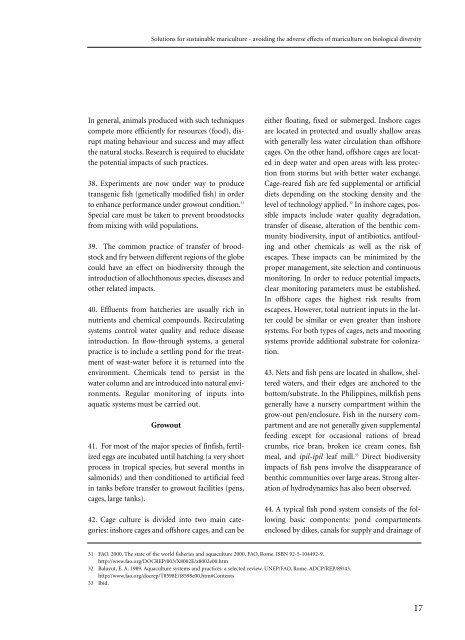Solutions for sustainable mariculture - Convention on Biological ...
Solutions for sustainable mariculture - Convention on Biological ...
Solutions for sustainable mariculture - Convention on Biological ...
- No tags were found...
You also want an ePaper? Increase the reach of your titles
YUMPU automatically turns print PDFs into web optimized ePapers that Google loves.
<str<strong>on</strong>g>Soluti<strong>on</strong>s</str<strong>on</strong>g> <str<strong>on</strong>g>for</str<strong>on</strong>g> <str<strong>on</strong>g>sustainable</str<strong>on</strong>g> <str<strong>on</strong>g>mariculture</str<strong>on</strong>g> - avoiding the adverse effects of <str<strong>on</strong>g>mariculture</str<strong>on</strong>g> <strong>on</strong> biological diversityIn general, animals produced with such techniquescompete more efficiently <str<strong>on</strong>g>for</str<strong>on</strong>g> resources (food), disruptmating behaviour and success and may affectthe natural stocks. Research is required to elucidatethe potential impacts of such practices.38. Experiments are now under way to producetransgenic fish (genetically modified fish) in orderto enhance per<str<strong>on</strong>g>for</str<strong>on</strong>g>mance under growout c<strong>on</strong>diti<strong>on</strong>. 31Special care must be taken to prevent broodstocksfrom mixing with wild populati<strong>on</strong>s.39. The comm<strong>on</strong> practice of transfer of broodstockand fry between different regi<strong>on</strong>s of the globecould have an effect <strong>on</strong> biodiversity through theintroducti<strong>on</strong> of allochth<strong>on</strong>ous species, diseases andother related impacts.40. Effluents from hatcheries are usually rich innutrients and chemical compounds. Recirculatingsystems c<strong>on</strong>trol water quality and reduce diseaseintroducti<strong>on</strong>. In flow-through systems, a generalpractice is to include a settling p<strong>on</strong>d <str<strong>on</strong>g>for</str<strong>on</strong>g> the treatmentof wast-water be<str<strong>on</strong>g>for</str<strong>on</strong>g>e it is returned into theenvir<strong>on</strong>ment. Chemicals tend to persist in thewater column and are introduced into natural envir<strong>on</strong>ments.Regular m<strong>on</strong>itoring of inputs intoaquatic systems must be carried out.Growout41. For most of the major species of finfish, fertilizedeggs are incubated until hatching (a very shortprocess in tropical species, but several m<strong>on</strong>ths insalm<strong>on</strong>ids) and then c<strong>on</strong>diti<strong>on</strong>ed to artificial feedin tanks be<str<strong>on</strong>g>for</str<strong>on</strong>g>e transfer to growout facilities (pens,cages, large tanks).42. Cage culture is divided into two main categories:inshore cages and offshore cages, and can beeither floating, fixed or submerged. Inshore cagesare located in protected and usually shallow areaswith generally less water circulati<strong>on</strong> than offshorecages. On the other hand, offshore cages are locatedin deep water and open areas with less protecti<strong>on</strong>from storms but with better water exchange.Cage-reared fish are fed supplemental or artificialdiets depending <strong>on</strong> the stocking density and thelevel of technology applied. 32 In inshore cages, possibleimpacts include water quality degradati<strong>on</strong>,transfer of disease, alterati<strong>on</strong> of the benthic communitybiodiversity, input of antibiotics, antifoulingand other chemicals as well as the risk ofescapes. These impacts can be minimized by theproper management, site selecti<strong>on</strong> and c<strong>on</strong>tinuousm<strong>on</strong>itoring. In order to reduce potential impacts,clear m<strong>on</strong>itoring parameters must be established.In offshore cages the highest risk results fromescapees. However, total nutrient inputs in the lattercould be similar or even greater than inshoresystems. For both types of cages, nets and mooringsystems provide additi<strong>on</strong>al substrate <str<strong>on</strong>g>for</str<strong>on</strong>g> col<strong>on</strong>izati<strong>on</strong>.43. Nets and fish pens are located in shallow, shelteredwaters, and their edges are anchored to thebottom/substrate. In the Philippines, milkfish pensgenerally have a nursery compartment within thegrow-out pen/enclosure. Fish in the nursery compartmentand are not generally given supplementalfeeding except <str<strong>on</strong>g>for</str<strong>on</strong>g> occasi<strong>on</strong>al rati<strong>on</strong>s of breadcrumbs, rice bran, broken ice cream c<strong>on</strong>es, fishmeal, and ipil-ipil leaf mill. 33 Direct biodiversityimpacts of fish pens involve the disappearance ofbenthic communities over large areas. Str<strong>on</strong>g alterati<strong>on</strong>of hydrodynamics has also been observed.44. A typical fish p<strong>on</strong>d system c<strong>on</strong>sists of the followingbasic comp<strong>on</strong>ents: p<strong>on</strong>d compartmentsenclosed by dikes, canals <str<strong>on</strong>g>for</str<strong>on</strong>g> supply and drainage of31 FAO. 2000. The state of the world fisheries and aquaculture 2000. FAO, Rome. ISBN 92-5-104492-9.http://www.fao.org/DOCREP/003/X8002E/x8002e00.htm32 Baluyut, E. A. 1989. Aquaculture systems and practices: a selected review. UNEP/FAO, Rome. ADCP/REP/89/43.http://www.fao.org/docrep/T8598E/t8598e00.htm#C<strong>on</strong>tents33 Ibid.17
















